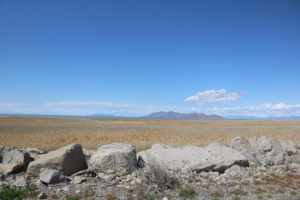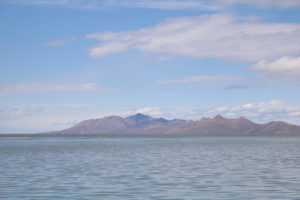Utah’s record-breaking winter and the Great Salt Lake
This winter has certainly been one for the ages — record-breaking snowfall, endless powder days, late-season skiing, etc. Members of the winter outdoor community are stoked to get outside in these all-time conditions, skiing, snowboarding, touring, snowshoeing, snowmobiling, etc. The stormy patterns we’ve experienced this season are welcomed by many. Naturally, this surplus of snow leads to the question: how will the snowpack affect the drying of the Great Salt Lake?
If you don’t already know what is happening, the western U.S. has experienced extreme drought for the last two decades. As a result, the Great Salt Lake has significantly dropped in water levels. Rivers feeding the lake have been diverted to support farms and growing cities. In the last four years alone, the lake has dropped approximately five feet. There are numerous environmental, economic, and public health consequences to the lake fully drying up. This includes impacts on fishing in the lake, mineral harvesting, and even ski resort operations.
Perhaps the most pressing concern for Utah is the air pollution. The drying of the lake will increase the number of dust storms all across the Salt Lake region. This sounds relatively harmless, but there are high concentrations of arsenic and other toxic, heavy metals present on the lakebed. When a dust storm rolls through, it will pick up these concentrations. Scientific reports argue that immediate action must be taken to prevent the unprecedented danger presented by the lake drying up. These reports, of course, are coming off of last winter. Which was particularly dry. Knowing this, one might presume that this year’s snowpack will solve the problem. Of course, Utah’s ecosystem is a lot more complex than we presume.
Overall, this year’s rain and snow are a step in the right direction for the Great Salt Lake. This year’s snowpack currently sits at approximately 169% of the average. In November, the lake reached a historic low of 4,188.5 ft above sea level. Thanks to early-season rain and snow, the Great Salt Lake’s water level has increased by more than one foot in just two months.
Utah reservoirs are currently sitting around fifty percent full with more water on the way. Water managers have been releasing some of the reservoirs into the watershed in anticipation of massive runoffs coming off this winter. This serves to benefit the Great Salt Lake as no one is irrigating downstream at this time. this means that excess water is able to reach the lake.
The Wasatch Mountains have already received average levels of snowfall. Given this, experts anticipate an additional rise of two to three feet in the upcoming months based on previous years. However, the Great Salt Lake needs to rise approximately eight to ten more feet to be at a healthy level. This will allow for the lakebed to be covered, ecosystems to be supported, and mineral companies to sustainably harvest the lake’s brine.
It’s tough to determine exactly how much this year’s snowpack will impact the Great Salt Lake, but it is safe to say that this will not be the end-all solution Utah needs. Conservation will become more important than ever for Utah’s future — even in the wet years. Relying on Utah’s snowpack alone to “fix” the Great Salt Lake is unrealistic for the situation. Climate change is causing our snowpack to become less reliable and rising temperatures will cause more evaporation of the lake. So, efforts to conserve water year-round are increasingly important to the environmental, economic, and public health of Salt Lake City, the Wasatch Mountain Range, and all of Utah. These efforts need to exist within not just individuals, but also major companies and organizations here in Utah.
The post Utah’s record-breaking winter and the Great Salt Lake appeared first on Wasatch Magazine.
Source: https://wasatchmag.com/utahs-record-breaking-winter-and-the-great-salt-lake/






